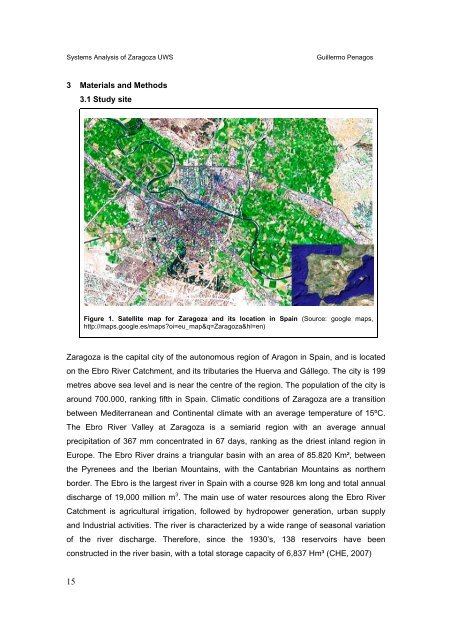Systems Analysis of Zaragoza Urban Water - SWITCH - Managing ...
Systems Analysis of Zaragoza Urban Water - SWITCH - Managing ...
Systems Analysis of Zaragoza Urban Water - SWITCH - Managing ...
Create successful ePaper yourself
Turn your PDF publications into a flip-book with our unique Google optimized e-Paper software.
<strong>Systems</strong> <strong>Analysis</strong> <strong>of</strong> <strong>Zaragoza</strong> UWS<br />
Guillermo Penagos<br />
3 Materials and Methods<br />
3.1 Study site<br />
Figure 1. Satellite map for <strong>Zaragoza</strong> and its location in Spain (Source: google maps,<br />
http://maps.google.es/maps?oi=eu_map&q=<strong>Zaragoza</strong>&hl=en)<br />
<strong>Zaragoza</strong> is the capital city <strong>of</strong> the autonomous region <strong>of</strong> Aragon in Spain, and is located<br />
on the Ebro River Catchment, and its tributaries the Huerva and Gállego. The city is 199<br />
metres above sea level and is near the centre <strong>of</strong> the region. The population <strong>of</strong> the city is<br />
around 700.000, ranking fifth in Spain. Climatic conditions <strong>of</strong> <strong>Zaragoza</strong> are a transition<br />
between Mediterranean and Continental climate with an average temperature <strong>of</strong> 15ºC.<br />
The Ebro River Valley at <strong>Zaragoza</strong> is a semiarid region with an average annual<br />
precipitation <strong>of</strong> 367 mm concentrated in 67 days, ranking as the driest inland region in<br />
Europe. The Ebro River drains a triangular basin with an area <strong>of</strong> 85.820 Km², between<br />
the Pyrenees and the Iberian Mountains, with the Cantabrian Mountains as northern<br />
border. The Ebro is the largest river in Spain with a course 928 km long and total annual<br />
discharge <strong>of</strong> 19,000 million m 3 . The main use <strong>of</strong> water resources along the Ebro River<br />
Catchment is agricultural irrigation, followed by hydropower generation, urban supply<br />
and Industrial activities. The river is characterized by a wide range <strong>of</strong> seasonal variation<br />
<strong>of</strong> the river discharge. Therefore, since the 1930’s, 138 reservoirs have been<br />
constructed in the river basin, with a total storage capacity <strong>of</strong> 6,837 Hm³ (CHE, 2007)<br />
15
















